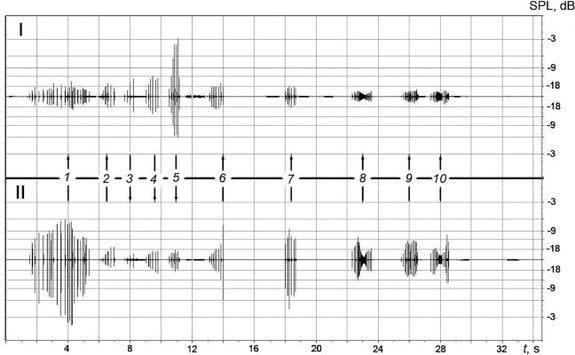Dolphins have a 'highly advanced' spoken language, study finds

Dolphins can carry on conversations in an advanced spoken language made up of pulses and whistles, a new study has found.
While marine biologists have long understood that dolphins communicate within their pods, the new research, which was conducted on two captive dolphins, is the first to link isolated signals to particular dolphins. The findings reveal that dolphins can string together "sentences" using a handful of "words."
"Essentially, this exchange of [pulses] resembles a conversation between two people," Vyacheslav Ryabov, the study's lead researcher, told Mashable.
SEE ALSO: Marine conservation efforts just took a major step forward
"The dolphins took turns in producing 'sentences' and did not interrupt each other, which gives reason to believe that each of the dolphins listened to the other's pulses before producing its own," he said in an email.

Image: VALERY HACHE/AFP/Getty Images
The study was published Aug. 21 in Physics and Mathematics, a journal of St. Petersburg Polytechnic University in Russia.
Ryabov is a senior researcher with the T. I. Vyazemsky Karadag Scientific Station – Nature Reserve, which is located in Feodosia — a port town in Crimea, the Ukrainian territory that Russia annexed in 2014.
For the study, Ryabov and his team recorded the acoustic signals of two quasi-stationary Black Sea bottlenose dolphins: Yasha, a male, and Yana, a female.
The duo has lived in the same concrete pool for about 20 years and have normal hearing.
Researchers used a two-channel system — with a frequency band of up to 220 kilohertz and a dynamic range of 81 decibels — to listen to "packs" of non-coherent pulses coming from each of the dolphins. Their audio recordings showed that the waveforms and spectra of each pulse changed from one pulse to another in every pack.
This suggests "that the set of spectral components in each pulse is a 'word' of the dolphin's spoken language, and a pack of [non-coherent pulses] is a 'sentence,'" Ryabov said.
"Dolphins' acoustic signals ... apparently are the signals of a highly advanced spoken language," he added.

Image: T. I. Vyazemsky Karadag Scientific Station–Nature Reserve
Michael Walsh, the clinical coordinator of the University of Florida's Aquatic Animal Health Program in Gainesville, said the dolphin study was an "important" development in the scientific quest to decode the acoustic signals of flippered mammals.
Walsh, who has studied dolphins for around 30 years and is a former head veterinarian at SeaWorld in Florida, was not involved in Ryabov's research.
Walsh said that, despite the excitement stirred up by the study, the finding that dolphins have conversations offers only a "small window" into understanding how dolphins actually relate to one another.
For both dolphins and humans, the vast majority of our communication is non-verbal (or non-acoustic), meaning we largely convey thoughts and feelings through eye contact, body language, gestures and other forms that don't involve words and pulses.
"There are many more aspects out there that are complementary [to language] and very important to how we understand animals in the wild," Walsh told Mashable.
Beyond communication, he noted that marine wildlife experts across the U.S. are conducting extensive research on deafness in dolphins. A 2010 study, for instance, found that around half of bottlenose dolphins that are stranded on the beach had significant hearing deficits.
"To me, that's ground-breaking," Walsh said of the research on dolphin deafness. "That results in them not being able to function anymore."
